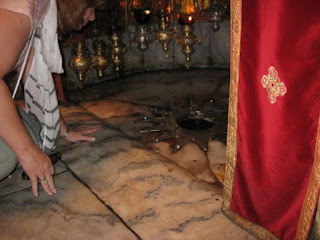 We visited two alternate sites for the site of Jesus’ crucifixion and burial: the Holy Sepulchre, the traditional site for the past 1700 years, and the Garden Tomb, a site discovered in the late 1880s that better matches the geography of the bible narratives. In 300 AD, Constantine built a church here, and several other churches were built here since, some on top of the previous, some next to adjacent churches. Hence, the mismatch group of walls you see in pictures of the church of the Holy Sepulchre, where Sandy is standing in the photo.
We visited two alternate sites for the site of Jesus’ crucifixion and burial: the Holy Sepulchre, the traditional site for the past 1700 years, and the Garden Tomb, a site discovered in the late 1880s that better matches the geography of the bible narratives. In 300 AD, Constantine built a church here, and several other churches were built here since, some on top of the previous, some next to adjacent churches. Hence, the mismatch group of walls you see in pictures of the church of the Holy Sepulchre, where Sandy is standing in the photo. A group of archaeologists discovered another area near the Damascus gate on the north side, that also may be the site of Jesus’ death and burial. This place has had a garden, an underwater cistern for the garden, markings in the rocks that look like a skull, a tomb with the burial slab on the right side, etc. Whichever site is correct doesn’t really matter. What matters is the truth of the events and the resurrection that occurred 3 days later!
A group of archaeologists discovered another area near the Damascus gate on the north side, that also may be the site of Jesus’ death and burial. This place has had a garden, an underwater cistern for the garden, markings in the rocks that look like a skull, a tomb with the burial slab on the right side, etc. Whichever site is correct doesn’t really matter. What matters is the truth of the events and the resurrection that occurred 3 days later! We also visited many excavations. Here is a sample where Sandy is standing next to a spot where they found a wall from the 8th century BC, corresponding to when Solomon built the first temple, and another wall that dates to the 1st century BC, corresponding to the time under Hasmonean control. We also visited the tunnel excavations along the western wall of the temple mount. This tunnel exposes the extension of the western wall everyone is familiar with as the Wailing Wall. These are the original walls of the temple mount Herod the Great built when he rebuilt the temple for the Jews.
We also visited many excavations. Here is a sample where Sandy is standing next to a spot where they found a wall from the 8th century BC, corresponding to when Solomon built the first temple, and another wall that dates to the 1st century BC, corresponding to the time under Hasmonean control. We also visited the tunnel excavations along the western wall of the temple mount. This tunnel exposes the extension of the western wall everyone is familiar with as the Wailing Wall. These are the original walls of the temple mount Herod the Great built when he rebuilt the temple for the Jews.We have seen so much in these past 7 or 8 days that we will never read the bible the same way. We have seen physical evidence of where so many Old Testament and New Testament people lived and what they built. Not that we needed any affirmation, but we have a better understanding of what took place and how people lived. We are changed!






















